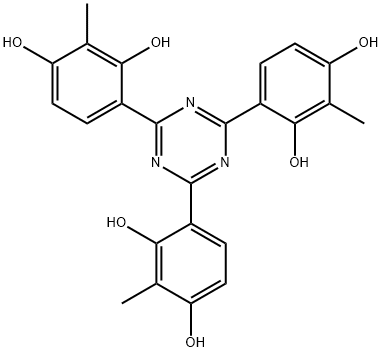
Zhejiang Kinso Technology Co., Ltd. is a manufacturer and supplier of 2,4,6-Tris(2,4-dihydroxy-3-methylphenyl)-1,3,5-triazine CAS 434942-20-8 in China. This series is designed to enhance productivity and efficiency.
| Product name | 2, 4, 6-Tris(2, 4-dihydroxy-3-methylphenyl)-1, 3, 5-triazine |
| CAS NO. | 434942-20-8 |
| EINECS NO. |
|
| Molecular formula | C24H21N3O6 |
| Molecular weight | 447.44 |
| Use | UV-700 |
| Structural formula |
 |
1. Structure Information
The parent nucleus of the compound is a triazine ring (1,3,5-triazine), which is substituted with three phenyl groups containing hydroxyl and methyl functionalities. Specifically, these phenyl groups are 2,4-dihydroxy-3-methylphenyl.
2. Physical and Chemical Properties
The compound typically appears as a solid (yellow powder) with a melting point exceeding 300°C. Its solubility is limited, with a water solubility of approximately 3.0×10^-3 g/L at 25°C.
1. Polymer Material Modification
This compound can serve as a UV absorber or antioxidant due to the presence of multiple phenolic hydroxyl groups in its molecular structure. These groups enable it to scavenge free radicals and absorb ultraviolet radiation, thereby enhancing the weather resistance of plastics such as ABS and PBT. Additionally, similar triazine derivatives (e.g., FR 245) have been utilized in flame retardant applications, suggesting that this compound may exhibit thermal stability and suitability for high-temperature processing materials.
2. Intermediates in Organic Synthesis
The reactive sites of the triazine ring and hydroxyl groups render this compound valuable for the synthesis of complex organic molecules, including pharmaceuticals and functional materials. The methyl substituents may enhance the compound's hydrophobicity, making it suitable for the development of specialized coatings and advanced functional materials.
3. Biological and Chemical Sensing
Structures containing hydroxyl groups may possess metal chelation capabilities, enabling potential applications in water treatment processes or catalytic systems.
Store the compound under light-protected conditions at -20°C.
Avoid exposure to high temperatures and strong oxidizing agents. Protective equipment, such as gloves and goggles, should be worn during handling.